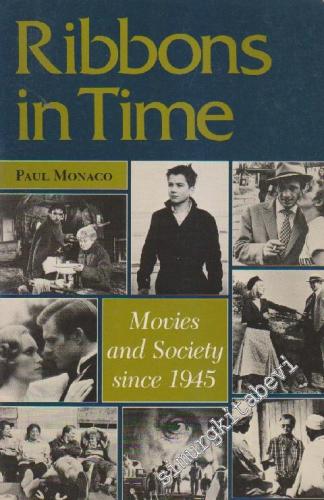1199166862
552991

https://www.simurgkitabevi.com/ribbons-in-time-movies-and-society-since-1945
Ribbons in Time: Movies and Society Since 1945 - #smrgSAHAF
0.00
Two academic approaches to film. Monaco's study provides brief rundowns on four postwar national cinemas, attempting to place them in some broader historical perspective. His examination of German cinema before the rise of Fassbinder, Herzog, et al., is illuminating; he does break some new ground by examining these films' attitudes toward the war and Nazism. He concludes with some stale observations about modern American films and their nostalgia for bygone eras, adding little new. Ryan and Kellner's approach is more overtly political, but dull. The authors contend that, after a brief flirtation with anti-Establishment attitudes from 1967 to 1971, Hollywood has since been courting the status quo. However, their case for the 1967-71 period is weakly made; the films seem for the most part to be fumbling attempts to cash in on trendy political postures. And, in modern Hollywood's stampede to produce blockbuster hits a la Beverly Hills Cop , it is only logical that they reflect broad-based (read: conservative) political thinking. Both books do try to see films as more than entertainment, but they seem either to be ignorant of past similar works or enamored of preconceived notions that are clumsily presented. Thomas Wiener, formerly with "American Film," Washington, D.C.
Two academic approaches to film. Monaco's study provides brief rundowns on four postwar national cinemas, attempting to place them in some broader historical perspective. His examination of German cinema before the rise of Fassbinder, Herzog, et al., is illuminating; he does break some new ground by examining these films' attitudes toward the war and Nazism. He concludes with some stale observations about modern American films and their nostalgia for bygone eras, adding little new. Ryan and Kellner's approach is more overtly political, but dull. The authors contend that, after a brief flirtation with anti-Establishment attitudes from 1967 to 1971, Hollywood has since been courting the status quo. However, their case for the 1967-71 period is weakly made; the films seem for the most part to be fumbling attempts to cash in on trendy political postures. And, in modern Hollywood's stampede to produce blockbuster hits a la Beverly Hills Cop , it is only logical that they reflect broad-based (read: conservative) political thinking. Both books do try to see films as more than entertainment, but they seem either to be ignorant of past similar works or enamored of preconceived notions that are clumsily presented. Thomas Wiener, formerly with "American Film," Washington, D.C.
Yorum yaz
Bu kitabı henüz kimse eleştirmemiş.





















